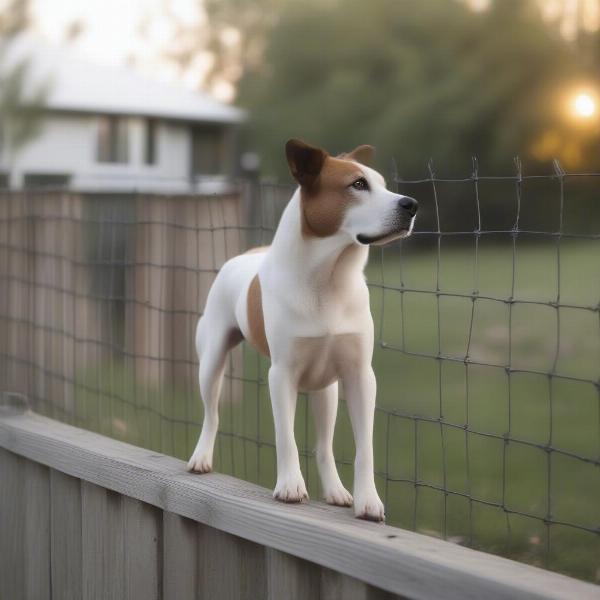A dog on a fence can be a common sight, but it can also be a sign of underlying issues or potential dangers. Whether your furry friend is perched proudly surveying their domain or anxiously pacing the perimeter, understanding why your dog is on the fence is crucial for their safety and well-being. This article explores the various motivations behind this behavior, from simple curiosity to more complex emotional needs, and offers practical solutions to ensure your dog stays safe and happy.
Why Do Dogs Like Being on the Fence?
Several factors can contribute to a dog’s fondness for the fence. Sometimes, it’s pure curiosity. The fence offers a vantage point, allowing them to observe the world beyond their yard. Sights, sounds, and smells from the street can be incredibly stimulating for a dog. Other times, the motivation might be territorial. Dogs have a natural instinct to protect their home turf, and the fence becomes their frontline defense against perceived intruders. They might bark at passersby, other animals, or even rustling leaves, asserting their dominance.  Dog on fence looking out
Dog on fence looking out
However, a dog on a fence could also indicate boredom, loneliness, or anxiety. If your dog spends excessive time pacing the fence line, especially when you’re away, it could be a sign of separation anxiety or a lack of mental stimulation. Similarly, if your dog is constantly trying to escape over or under the fence, they might be seeking adventure, companionship, or simply a change of scenery.
Addressing the Fence-Climbing Behavior
If your dog’s fence-climbing habit is becoming a problem, several strategies can help. First, ensure your dog is receiving adequate physical and mental exercise. Regular walks, playtime, and interactive toys can help alleviate boredom and release pent-up energy. Consider enrolling your dog in agility training or other dog sports to provide further stimulation.
Creating a more enriching environment in your yard can also deter fence-climbing. Provide a comfortable resting area, plenty of chew toys, and perhaps even a digging pit to satisfy their natural instincts. For dogs with separation anxiety, desensitization training and creating a positive association with your departure can be beneficial. This might involve leaving for short periods and gradually increasing the duration, rewarding calm behavior upon your return.
Ensuring Your Dog’s Safety on the Fence
Regardless of the reason behind your dog’s fence habit, safety should always be a top priority. Ensure your fence is secure and tall enough to prevent escapes. Check for any gaps or weak points that your dog could exploit. electric fense for dogs are a popular choice for many dog owners. For smaller dogs, you might consider electric pet fence for small dogs specifically designed for their size. If your dog likes to climb, consider adding coyote rollers or other deterrents to the top of the fence. Regularly inspect your fence for damage and address any issues promptly.
Dealing with Territorial Barking from the Fence
If your dog’s fence-related behavior involves excessive barking at passersby, training is key. Teach your dog a “quiet” command and reward them for remaining silent when people or animals pass by. You can also try redirecting their attention with a toy or treat when they start barking. Creating visual barriers, such as planting shrubs along the fence line, can also help reduce their exposure to triggers. dog fence for garage can also be considered if your dog spends a lot of time near the garage and barks at things it sees outside.
Conclusion
A dog on a fence isn’t always cause for alarm, but it’s important to understand the underlying reasons and address any potential safety or behavioral issues. By providing adequate exercise, enrichment, and training, you can help your dog develop healthier habits and enjoy their yard safely. Addressing the root cause of the behavior, rather than simply punishing it, is crucial for fostering a positive relationship with your furry companion. Remember, a happy and well-adjusted dog is less likely to seek solace or excitement on the fence.
FAQ
- Why does my dog pace the fence line? Pacing can indicate boredom, territoriality, anxiety, or a desire to explore beyond the fence.
- How can I stop my dog from jumping the fence? Ensure the fence is secure and tall enough. Consider adding deterrents like coyote rollers. Increase exercise and enrichment to reduce boredom.
- Is it safe for my dog to be on the fence? It depends on the fence’s stability and your dog’s size and climbing ability. Always prioritize safety and supervise your dog.
- What can I do about excessive barking at the fence? Train a “quiet” command, redirect their attention, and create visual barriers.
- How can I make my yard more stimulating for my dog? Provide interactive toys, a digging pit, and opportunities for exploration.
- My dog only climbs the fence when I’m gone. What should I do? This could be a sign of separation anxiety. Consult a veterinarian or professional dog trainer for guidance.
- Are electric fences safe for dogs? small dog fence and portable outdoor dog fence are available and can be safe when used correctly. Consult with a professional for proper installation and training.
ILM Dog is your trusted resource for all things canine. We offer expert advice on dog breeds, health, training, nutrition, grooming, and more. From puppy care to senior dog care, we provide practical and reliable information to help you navigate every stage of your dog’s life. Whether you’re a new dog owner or a seasoned pro, we’re here to support you in providing the best possible care for your furry friend. Contact us today for personalized guidance and discover a wealth of resources to enhance your dog’s well-being. Email: [email protected], Phone: +44 20-3965-8624. Visit ILM Dog for more expert advice and valuable resources.